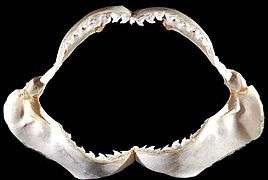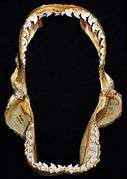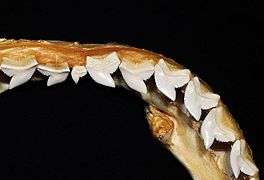Tiger shark
The tiger shark (Galeocerdo cuvier[3]) is a species of requiem shark and the only extant member of the genus Galeocerdo. It is a large macropredator, capable of attaining a length over 5 m (16 ft 5 in).[4] Populations are found in many tropical and temperate waters, especially around central Pacific islands. Its name derives from the dark stripes down its body, which resemble a tiger's pattern, but fade as the shark matures.[5]
| Tiger shark | |
|---|---|
 | |
 | |
| Scientific classification | |
| Kingdom: | Animalia |
| Phylum: | Chordata |
| Class: | Chondrichthyes |
| Order: | Carcharhiniformes |
| Family: | Carcharhinidae |
| Genus: | Galeocerdo |
| Species: | G. cuvier |
| Binomial name | |
| Galeocerdo cuvier | |
 | |
| Tiger shark range | |
| Synonyms | |
|
Squalus cuvierPeron and Lesueur, 1822 | |
The tiger shark is a solitary, mostly nocturnal hunter. It is notable for having the widest food spectrum of all sharks, with a range of prey that includes crustaceans, fish, seals, birds, squid, turtles, sea snakes, dolphins, and even other smaller sharks. It also has a reputation as a "garbage eater",[5] consuming a variety of inedible, man-made objects that linger in its stomach. Though apex predators, tiger sharks are sometimes taken by groups of killer whales.[6] It is considered a near threatened species due to finning and fishing by humans.[2]
The tiger shark is second only to the great white in recorded fatal attacks on humans.[7]
Taxonomy
The shark was first described by Peron and Lesueur in 1822, and was given the name Squalus cuvier.[4] Müller and Henle in 1837 renamed it Galeocerdo tigrinus.[7] The genus, Galeocerdo, is derived from the Greek galeos, which means shark, and kerdo, the word for fox.[7] It is often colloquially called the man-eater shark.[7]
The tiger shark is a member of the order Carcharhiniformes, the most species-rich order of sharks, with more than 270 species also including the small catsharks and hammerhead sharks.[4] Members of this order are characterized by the presence of a nictitating membrane over the eyes, two dorsal fins, an anal fin, and five gill slits. It is the largest member of the Carcharhinidae family, commonly referred to as requiem sharks. This family consists of mostly slender but powerful mid- to large-sized sharks and includes some other well-known sharks, such as the blue shark (Prionace glauca), lemon shark (Negaprion brevirostris), and bull shark (Carcharhinus leucas).[5]
Description
The tiger shark commonly attains a length of 3.25–4.25 m (10 ft 8 in–13 ft 11 in) and weighs around 385–635 kg (849–1,400 lb).[7] It is dimorphic, with exceptionally large females reportedly measuring over 5 m (16 ft 5 in), and the largest males 4 m (13 ft 1 in). Weights of particularly large female tiger sharks can exceed 900 kg (2,000 lb).[8][9] One pregnant female caught off Australia reportedly measured 5.5 m (18 ft 1 in) long and weighed 1,524 kg (3,360 lb). Even larger unconfirmed catches have been claimed.[10] Some papers have accepted a record of an exceptional 7.4 m (24 ft 3 in) length for a tiger shark, but since this is far larger than any scientifically observed specimen, verification would be needed.[11][12]
Among the largest extant sharks, the tiger shark ranks in average size only behind the whale shark (Rhincodon typus), the basking shark (Cetorhinus maximus), and the great white shark (Carcharodon carcharias). Some other species such as megamouth sharks (Megachasma pelagios), Pacific sleeper sharks (Somniosus pacificus), Greenland sharks (Somniosus microcephalus), and bluntnose sixgill sharks (Hexanchus griseus) broadly overlap in size with the tiger shark, but as these species are comparatively poorly studied, whether their typical mature size matches that of the tiger shark is unclear.[7][10] The great hammerhead (Sphyrna mokarran), a member of the same taxonomic order as the tiger shark, has a similar or even greater average body length, but is lighter and less bulky, with a maximum known weight of 580 kg (1,280 lb).[13]
Tiger shark teeth are unique with very sharp, pronounced serrations and an unmistakable sideways-pointing tip. Such dentition has developed to slice through flesh, bone, and other tough substances such as turtle shells. Like most sharks, its teeth are continually replaced by rows of new teeth throughout the shark's life. Relative to the shark's size, tiger shark teeth are considerably shorter than those of a great white shark, but they are nearly as broad as the root as the great white's teeth and are arguably better suited to slicing through hard-surfaced prey.[14][15]
A tiger shark generally has long fins to provide lift as the shark maneuvers through water, while the long upper tail provides bursts of speed. The tiger shark normally swims using small body movements.[16] Its high back and dorsal fin act as a pivot, allowing it to spin quickly on its axis, though the shark's dorsal fins are distinctively close to its tail.
 Jaws
Jaws Jaws, wide open
Jaws, wide open Upper teeth
Upper teeth Lower teeth
Lower teeth
Skin
The skin of a tiger shark can typically range from blue to light green with a white or light-yellow underbelly. The advantage of this is that when it is hunting for its prey, when prey looks at the shark from above, the shark will be camouflaged, since the water below is darker And when prey is below the shark and looks up, of course because of the sun, it is lighter so that the light underbelly will also camouflage the shark. This is known as countershading. Dark spots and stripes are most visible in young sharks and fade as the shark matures. Its head is somewhat wedge-shaped, which makes it easy to turn quickly to one side.[5][17] They have small pits on the snout which hold electroreceptors called the ampullae of Lorenzini, which enable them to detect electric fields, including the weak electrical impulses generated by prey, which helps them to hunt.[14] Tiger sharks also have a sensory organ called a lateral line which extends on their flanks down most of the length of their sides. The primary role of this structure is to detect minute vibrations in the water. These adaptations allow the tiger shark to hunt in darkness and detect hidden prey.[18]
Vision
Sharks do not have moveable upper or lower eyelids, but the tiger shark—among other sharks—has a nictitating membrane, a clear eyelid that can cover the eye.[19] A reflective layer behind the tiger shark's retina, called the tapetum lucidum, allows light-sensing cells a second chance to capture photons of visible light. This enhances vision in low-light conditions.[20]
Distribution and habitat

The tiger shark is often found close to the coast, mainly in tropical and subtropical waters throughout the world.[7] Its behavior is primarily nomadic, but is guided by warmer currents, and it stays closer to the equator throughout the colder months. It tends to stay in deep waters that line reefs, but it does move into channels to pursue prey in shallower waters. In the western Pacific Ocean, the shark has been found as far north as Japan and as far south as New Zealand.[4] It has also been recorded in the Mediterranean, once off Spain and once off Sicily.[21]
Tiger sharks can be seen in the Gulf of Mexico, North American beaches, and parts of South America. It is also commonly observed in the Caribbean Sea. Other locations where tiger sharks are seen include off Africa, China, India, Australia, and Indonesia.[5]
Certain tiger sharks have been recorded at depths just shy of 900 m (3,000 ft),[7] but some sources claim they move into shallow water normally thought to be too shallow for a species of its size.[5] A recent study showed the average tiger shark would be recorded at 350 m (1,100 ft), making tiger sharks uncommonly seen in shallow water. However, tiger sharks in Hawaii have been observed in depths as shallow as 3.05 m (10.0 ft) and regularly observed in coastal waters at depths of 6 to 12 m (20 to 40 ft).
Feeding
The tiger shark is an apex predator[22] and has a reputation for eating almost anything.[7] These predators swim close inland to eat at night, and during the day swim out into deeper waters.[23] Young tiger sharks are found to feed largely on small fish, as well as various small jellyfish, and mollusks including cephalopods. Around the time they attain 2.3 m (7.5 ft), or near sexual maturity, their selection expands considerably, and much larger animals become regular prey.[24] Numerous fish, crustaceans, sea birds, sea snakes,[25] marine mammals (e.g. bottlenose dolphins (Tursiops), common dolphins (Delphinus),[26] spotted dolphins (Stenella),[27] dugongs (Dugong dugon), seals and sea lions, and sea turtles (including the three largest species: the leatherback (Dermochelys coriacea),[28] the loggerhead (Caretta caretta)[29] and the green sea turtles (Chelonia mydas),[24]) are regularly eaten by adult tiger sharks. In fact, adult sea turtles have been found in up to 20.8% of studied tiger shark stomachs, indicating somewhat of a dietary preference for sea turtles where they are commonly encountered.[30] They also eat other sharks (including adult sandbar sharks (Carcharhinus plumbeus)), as well as rays, and sometimes even other tiger sharks.[5][24]
Due to high risk of predation, dolphins often avoid regions inhabited by tiger sharks.[31] Injured or ailing whales may also be attacked and eaten. A group was documented killing an ailing humpback whale (Megaptera novaeangliae) in 2006 near Hawaii.[32] A scavenger, the tiger shark will feed on dead whales, and has been documented doing so alongside great white sharks.[33]
Evidence of dugong predation was identified in one study that found dugong tissue in 15 of 85 tiger sharks caught off the Australian coast.[34] Additionally, examination of adult dugongs has shown scars from failed shark attacks.[35] To minimize attacks, dugong microhabitats shift similarly to those of known tiger shark prey when the sharks are abundant.[36]
The broad, heavily calcified jaws and nearly terminal mouth, combined with robust, serrated teeth, enable the tiger shark to take on these large prey.[31] In addition, excellent eyesight and acute sense of smell enable it to react to faint traces of blood and follow them to the source. The ability to pick up low-frequency pressure waves enables the shark to advance towards an animal with confidence, even in murky water.[16] The shark circles its prey and studies it by prodding it with its snout.[16] When attacking, the shark often eats its prey whole, although larger prey are often eaten in gradual large bites and finished over time.[16]
Notably, terrestrial mammals, including horses (Equus ferus caballus), goats (Capra aegagrus hircus), sheep (Ovis aries), dogs (Canis lupus familiaris), cats (Felis catus), and brown rats (Rattus norvegicus), are fairly common in the stomach contents of tiger sharks around the coasts of Hawaii.[24] In one case, remains of two flying foxes were found in the stomach of this shark.[37] Because of its aggressive and indiscriminate feeding style, it often mistakenly eats inedible objects, such as automobile license plates, oil cans, tires, and baseballs.[5]
Predation by killer whales
Although tiger sharks are apex predators, they are often killed and taken as prey by pods of killer whales. The killer whales method of hunting tiger sharks is to drive them to the surface, then grab them mid-body and hold them upside down to induce tonic immobility which drowns the shark. The killer whales then bite off the sharks fins then disembowel and devour them midwater.[6]
Swimming efficiency and stealth
All tiger sharks generally swim slowly, which, combined with cryptic coloration, may make them difficult for prey to detect in some habitats. They are especially well camouflaged against dark backgrounds.[31] Despite their sluggish appearance, tiger sharks are one of the strongest swimmers of the carcharhinid sharks. Once the shark has come close, a speed burst allows it to reach the intended prey before it can escape.[31]
Reproduction
Males reach sexual maturity at 2.3 to 2.9 m (7.5 to 9.5 ft) and females at 2.5 to 3.5 m (8.2 to 11.5 ft).[14] Typical weight of relatively young sexually mature specimens, which often locally comprise the majority of tiger sharks encountered per game-fishing and scientific studies, is around 80 to 130 kg (180 to 290 lb).[15][38] Females mate once every three years.[5] They breed by internal fertilization. The male inserts one of his claspers into the female's genital opening (cloaca), acting as a guide for the sperm. The male uses his teeth to hold the female still during the procedure, often causing the female considerable discomfort. Mating in the Northern Hemisphere generally takes place between March and May, with birth between April and June the following year. In the Southern Hemisphere, mating takes place in November, December, or early January. The tiger shark is the only species in its family that is ovoviviparous; its eggs hatch internally and the young are born live when fully developed.[7]
The young develop inside the mother's body up to 16 months. Litters range from 10 to 80 pups.[7] A newborn is generally 51 to 76 cm (20 to 30 in) long.[7] How long tiger sharks live is unknown, but they can live longer than 12 years.[5]
Conservation

The tiger shark is captured and killed for its fins, flesh, and liver. It is caught regularly in target and nontarget fisheries. Several populations have declined where they have been heavily fished. Continued demand for fins may result in further declines in the future. They are considered a near threatened species due to excessive finning and fishing by humans according to International Union for Conservation of Nature.[2] In June 2018 the New Zealand Department of Conservation classified the tiger shark as "Migrant" with the qualifier "Secure Overseas" under the New Zealand Threat Classification System.[39]
While shark fin has very few nutrients, shark liver has a high concentration of vitamin A, which is used in the production of vitamin oils. In addition, the tiger shark is captured and killed for its distinct skin, as well as by big-game fishers.[7]
In 2010, Greenpeace International added the tiger shark to its seafood red list, which is a list of fish commonly sold around the world, and which have a very high risk of being sourced from unsustainable fisheries.[40]
Relationship with humans
Although sharks rarely bite humans, the tiger shark is reported to be responsible for a large share of fatal shark-bite incidents, and is regarded as one of the most dangerous shark species.[41][42] They often visit shallow reefs, harbors, and canals, creating the potential for encounter with humans.[5] The tiger shark also dwells in river mouths and other runoff-rich water.[7][14] While the tiger shark is considered to be one of the sharks most dangerous to humans, its bite rate is low.[43] It ranks second on the list of number of recorded bites on humans, behind only the great white shark.[7][41] Typically, three to four shark bites occur per year in Hawaii, but they are rarely fatal; one notable survivor of such an attack is surfing champion Bethany Hamilton, who lost her left arm at age 13 to a tiger shark in 2003. This bite rate is very low, considering that thousands of people swim, surf, and dive in Hawaiian waters every day.[43] Human interactions with tiger sharks in Hawaiian waters have been shown to increase between September and November, when tiger shark females are believed to migrate to the islands to give birth.[44]
Between 1959 and 2000, 4,668 tiger sharks were culled in an effort to protect the tourism industry. Despite damaging the shark population, these efforts were shown to be ineffective in decreasing the number of interactions between humans and tiger sharks. Feeding sharks in Hawaii (except for traditional Hawaiian cultural or religious practices) is illegal,[45][46] and interaction with them, such as cage diving, is discouraged. South African shark behaviorist and shark diver Mark Addison demonstrated divers could interact and dive with them outside of a shark cage in a 2007 Discovery Channel special,[47] and underwater photographer Fiona Ayerst swam with them in the Bahamas.[47][48] At "Tiger Beach" off Grand Bahama, uncaged diving with - and even the handling of - female tiger sharks has become a routine occurrence.[49]
Mythology
The tiger shark is considered to be sacred na ʻaumakua (ancestor spirits) by some native Hawaiians, who think their eyeballs have special powers of visual perception.[50]
References
- "Fossilworks Galeocerdo cuvier Peron and LeSueur 1822 (tiger shark)".
- Simpfendorfer, C. (2009). "Galeocerdo cuvier". IUCN Red List of Threatened Species. 2009: e.T39378A10220026. doi:10.2305/IUCN.UK.2009-2.RLTS.T39378A10220026.en.
- "ITIS Report – Galeocerdo cuvier". Integrated Taxonomic Information System!. Retrieved 30 December 2015.
- Froese, Rainer and Pauly, Daniel, eds. (2011). "Galeocerdo cuvier" in FishBase. July 2011 version.
- Ritter, Erich K. (15 December 1999). "Fact Sheet: Tiger Sharks". Shark Info.
- Video of Killer Whales killing and devouring a Tiger Shark
- Knickle, Craig. "Tiger Shark Biological Profile". Florida Museum of Natural History Ichthyology Department.
- Hinman, B. (2015). Keystone Species That Live in the Sea and Along the Coastline. Mitchell Lane Publishers, Inc.
- Ramirez, F., & Davenport, T. L. (2013). Elasmobranchs from marine and freshwater environments in Colombia: A review. Current Politics and Economics of South and Central America, 6(4), 483.
- Wood, Gerald (1983). The Guinness Book of Animal Facts and Feats. ISBN 978-0-85112-235-9.
- Simpfendorfer, C. A.; Goodreid, A. B.; McAuley, R. B. (2001). "Size, sex and geographic variation in the diet of the tiger shark, Galeocerdo cuvier, from Western Australian waters". Environmental Biology of Fishes. 61 (1): 37–46. doi:10.1023/A:1011021710183.
- Tobuni, I. M.; Benabdallah, B. A. R.; Serena, F.; Shakman, E. A. (2016). "First documented presence of Galeocerdo cuvier (Péron & Lesueur, 1822) (ELASMOBRANCHII, CARCHARHINIDAE) in the Mediterranean basin (Libyan waters)". Marine Biodiversity Records. 9 (1): 94. doi:10.1186/s41200-016-0089-3.
- "Record Hammerhead Pregnant With 55 Pups". Associated Press via Discovery News. July 1, 2006. Archived from the original on June 22, 2011. Retrieved October 18, 2008.CS1 maint: unfit url (link)
- Tiger shark, Galeocerdo cuvier at marinebio.org Accessed July, 2011.
- Randall, J. E. (1992). Review of the biology of the tiger shark (Galeocerdo cuvier). Marine and Freshwater Research, 43(1), 21-31.
- "Tiger Shark". ladywildlife.com. Retrieved 2006-12-21.
- Canadian Shark Research Laboratory, Tiger Shark – Bedford Institute of Oceanography
- Tiger Shark – The Province of New Brunswick Canada. New Brunswick. Retrieved 2011-06-09.
- Gilbert, Perry W. (1970). "Studies on the anatomy, physiology, and behavior of sharks" (PDF). Mote Marine Laboratory. Retrieved March 12, 2018.
- Hart, Nathan S.; Lisney, Thomas J.; Collin, Shaun P. (2006). "Visual Communication in Elasmobranchs". In Ladich, Friedrich (ed.). Communication in Fishes. Enfield, NH: Science Publishers. pp. 346–347. ISBN 9781578084067. OCLC 63187557.
- "Galeocerdo cuvier". CIESM Atlas of Exotic Fishes in the Mediterranean Sea. CIESM. Retrieved 15 January 2017.
- Heithaus, Michael R. (May 2001). "The Biology of Tiger Sharks, Galeocerdo cuvier, in Shark Bay, Western Australia: Sex Ratio, Size Distribution, Diet, and Seasonal Changes in Catch Rates". Environmental Biology of Fishes. 61 (1): 25–36. doi:10.1023/A:1011021210685.
- Tiger Sharks, Galeocerdo cuvier. marinebio.org
- Lowe, Christopher G.; Wetherbee, Bradley M.; Crow, Gerald L.; Tester, Albert L. (1996). "Ontogenetic dietary shifts and feeding behavior of the tiger shark, Galeocerdo cuvier, in Hawaiian waters" (PDF). Environmental Biology of Fishes. 47 (2): 203. doi:10.1007/BF00005044. Archived from the original (PDF) on 2009-01-07.
- Heithaus, M. R.; Dill, L.; Marshall, G.; Buhleier, B. (2004). "Habitat use and foraging behavior of tiger sharks (Galeocerdo cuvier) in a seagrass ecosystem" (PDF). Marine Biology. 140 (2): 237–248. doi:10.1007/s00227-001-0711-7.
- Heithaus, M. R.; Dill, L. (2002). "Food availability and tiger shark predation risk influence bottlenose dolphin habitat use" (PDF). Ecology. 83 (2): 480–491. doi:10.1890/0012-9658(2002)083[0480:FAATSP]2.0.CO;2. Archived from the original (PDF) on 2009-03-06.
- Maldini, Daniela (2003). "Evidence of predation by a tiger shark (Galeocerdo cuvier) on a spotted dolphin (Stenella attenuata) off Oahu, Hawaii" (PDF). Aquatic Mammals. 29 (1): 84–87. doi:10.1578/016754203101023915.
- Tiger Sharks Killed for Eating Leatherback Turtles. Shark Defenders (2011-04-16). Retrieved on 2013-03-23.
- Shark Bay Ecosystem Research Project. .fiu.edu. Retrieved on 2013-03-23.
- Witzell, W. N. (1987). Selective predation on large cheloniid sea turtles by tiger sharks (Galeocerdo cuvier). Japanese Journal of Herpetology, 12(1), 22-29.
- Heithaus, Michael R. (January 2001). "Predator–prey and competitive interactions between sharks (order Selachii) and dolphins (suborder Odontoceti): a review". Journal of Zoology. 253 (1): 53–68. CiteSeerX 10.1.1.404.130. doi:10.1017/S0952836901000061.
- Office of National Marine Sanctuaries (2012-08-07). "Humpback Whale Shark Attack: A Natural Phenomenon Caught on Camera".
- Dudley, Sheldon F. J.; Anderson-Reade, Michael D.; Thompson, Greg S.; McMullen, Paul B. (2000). "Concurrent scavenging off a whale carcass by great white sharks, Carcharodon carcharias, and tiger sharks, Galeocerdo cuvier" (PDF). Fishery Bulletin. 98: 646–649. Retrieved 4 May 2010.
- Simpfendorfer, Colin A.; Goodreid, Adrian B.; McAuley, Rory B. (1 January 2001). "Size, Sex And Geographic Variation in the Diet of the Tiger Shark, Galeocerdo cuvier, From Western Australian Waters". Environmental Biology of Fishes. 61 (1): 37–46. doi:10.1023/A:1011021710183.
- Anderson, Paul K. (1995). "Scarring and photoidentification of dugongs (Dugong dugon) in Shark Bay, Western Australia" (PDF). Aquatic Mammals. 21 (3): 205–211. ISSN 0167-5427. Retrieved October 15, 2014.
- Wirsing, Aaron J.; Heithaus, Michael R.; Dill, Lawrence M. (July 2007). "Living on the edge: dugongs prefer to forage in microhabitats that allow escape from rather than avoidance of predators". Animal Behaviour. 74 (1): 93–101. doi:10.1016/j.anbehav.2006.11.016.
- Mikula, P. (2015). "Fish and amphibians as bat predators". European Journal of Ecology. 1 (1): 71–80. doi:10.1515/eje-2015-0010.
- Pepperell, J. 1992. Trends in the distribution, species composition and size of sharks caught by gamefish anglers off southeastern Australia, 1961-1990. In: J. Pepperell (ed.), Sharks: Biology and Fisheries. Australian Journal of Marine and Freshwater Research, pp. 213–225. CSIRO Publications, Melbourne, Australia.
- Duffy, Clinton A. J.; Francis, Malcolm; Dunn, M. R.; Finucci, Brit; Ford, Richard; Hitchmough, Rod; Rolfe, Jeremy (2018). Conservation status of New Zealand chondrichthyans (chimaeras, sharks and rays), 2016 (PDF). Wellington, New Zealand: Department of Conservation. p. 10. ISBN 9781988514628. OCLC 1042901090.
- Greenpeace International Seafood Red list. greenpeace.org
- "ISAF Statistics on Attacking Species of Shark". International Shark Attack File. Florida Museum of Natural History University of Florida. Retrieved 2020-07-20.
- Ritter, Erich K. (15 February 1999). "Which shark species are really dangerous?". Shark Info.
- "Tiger Shark Research Program". Shark & Reef Fish Research. Hawaii Institute of Marine Biology.
- Main, Douglas (September 10, 2013). "Hawaii tiger shark migration in fall coincides with rise in bites". CBS Science News. Retrieved October 15, 2014.
- "Prohibition of Shark Feeding". Hawaii Department of Land and Natural Resources, Hawaii Department of Agriculture. Archived from the original on 2014-08-20. Retrieved 2014-05-26.CS1 maint: BOT: original-url status unknown (link)
- "Federal Fishery Managers Vote To Prohibit Shark Feeding" (PDF). Western Pacific Regional Fishery Management Council. Retrieved 2014-05-26.
- Donahue, Ann (30 July 2007). "Shark Week: 'Deadly Stripes: Tiger Sharks'". LA Times.
- Riveting Shark Encounters: Fiona Ayerst recounts ... gentle tiger shark in the warm silky waters of the Bahamas. Magazines.co.za (June/July 2009)
- "Tiger shark handling". Jonathan Bird's Blue World. Retrieved February 28, 2017.
- "Hawaiian Sharks | Parts of a Shark and Behavior". www.mauiinformationguide.com. Retrieved 2019-10-01.
External links
| Wikimedia Commons has media related to Galeocerdo cuvier. |
| Wikispecies has information related to Galeocerdo cuvier |
- "Galeocerdo cuvier". Integrated Taxonomic Information System. Retrieved 7 April 2006.
- General information Enchanted Learning. Retrieved January 22, 2005.
- "Different diet information" Shark Info. Retrieved January 22, 2005.
- "Tiger sharks in Hawaii" Research program. Retrieved January 22, 2005.
- "Tiger shark: Fact File" from National Geographic
- Tracking research on tiger sharks
- Pictures of tiger sharks
- Photos of Tiger shark on Sealife Collection
- Diver Has Been Friends With Tiger Shark For 20 Years!
